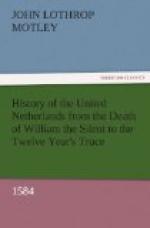What were the Estates? Without, at the present moment, any farther inquiries into that constitutional system which had been long consolidating itself, and was destined to exist upon a firmer basis for centuries longer, it will be sufficient to observe, that the great characteristic of the Netherland government was the municipality.
Each Province contained a large number of cities, which were governed by a board of magistrates, varying in number from twenty to forty. This college, called the Vroedschap (Assembly of Sages), consisted of the most notable citizens, and was a self-electing body—a close corporation—the members being appointed for life, from the citizens at large. Whenever vacancies occurred from death or loss of citizenship, the college chose new members—sometimes immediately, sometimes by means of a double or triple selection of names, the choice of one from among which was offered to the stadtholder of the province. This functionary was appointed by the Count, as he was called, whether Duke of Bavaria or of Burgundy, Emperor, or King. After the abjuration of Philip, the governors were appointed by the Estates of each Province.
The Sage-Men chose annually a board of senators, or schepens, whose functions were mainly judicial; and there were generally two, and sometimes three, burgomasters, appointed in the same way. This was the popular branch of the Estates. But, besides this body of representatives, were the nobles, men of ancient lineage and large possessions, who had exercised, according to the general feudal law of Europe, high, low, and intermediate jurisdiction upon their estates, and had long been recognized as an integral part of the body politic, having the right to appear, through delegates of their order, in the provincial and in the general assemblies.




